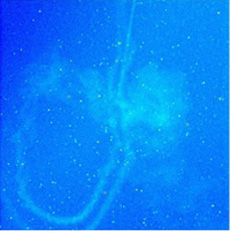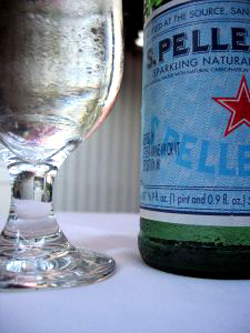

Ice trail from the Leonid Meteor Study. A celestial assault of ice from outer space, bombarding the earth and pock-marking the moon, is the source of our water.
|
| CHRIS MIDDLETON of Fountainhead is a consultant specializing in drink trend analysis, new product and brand development. |
|
July 2006
|
 |
The Origin of Water
Like Good Sci-Fi, It Came From Outer Space
Water is essential to life, as well as a favorite beverage. But where does it come from?
Water is the signature of our planet. We are the blue planet. The planet of life. But where did water come from? The latest discoveries in astrophysics point to water not being a natural terrestrial product but imported from the edges of our solar system.
Life on Earth evolved from water, a marriage of oxygen and hydrogen to form the most recognized chemical code, H2O. Seventy percent of the Earth’s surface is covered in water. Eighty percent of fruit and vegetables are made of water. Our bodies are 50 to 70 percent water. Three bucket loads a week, or an average 2.6 quarts a day— escapes our body. Sixty-five percent is removed in urine & feces, followed by twenty percent secreted through our skin and fifteen percent through our lungs.
The use of average figures to illustrate body hydration can be statistically misleading as factors like age, gender, body size, energy demands, geographical location and climate all contribute to a complex set of fluid possibilities. For example, an adult living in the tropics may need over 10.5 quarts each day, while someone living in a cold climate during winter may consume less than a pint. The issue is that no matter where we live, who we are, or how we consume water, it is essential part of life.
In The Beginning
While life has evolved and been sustained on Earth, the evidence suggests it did not start here. Herein lies the story of water, and from water arose life. Water and life’s origins are far more mysterious and exciting than we thought.
Carl Sagan poetically wrote, “we are made of star-stuff,” referring to the Earth being re-formed perhaps a second or even third time from the left-over detritus of exploded stars. Today’s Earth is about 4.6 billion years old, only a third of the age of our universe. Earth still has a life expectancy of another 7.5 billion years before our sun dies in a cataclysmic death.
The planetary picture that is emerging is that Earth was formed with very little water, or no water at all. The hydration of Earth came from comets and some hydrous asteroids. These sources are the Kuiper belt out past Neptune and the Oort cloud on the edges of our solar system. Comets are one of the most primitive members of our universe. Due to their remoteness and small size, they have not undergone much chemical change; they are frozen fossils of a long past epoch. While asteroids are more numerous (70 percent of visitations to comets’ 30 percent) they contain little water— mainly rock and metal.
Water is thought to have been first delivered here over 4 billion years ago, involving an intense bombardment of the inner solar system. One such attack is known as the lunar cataclysm, a period of celestial assault when the moon became most heavily pock-marked. The Earth received 13 to 500 times more “hits,” and having a greater critical mass was able to hold much of the water (ice); whereas the moon lost most of its frozen water to the emptiness of space. Tantalizing speculation is that some of these comets may have incubated in the Jovian sub-nebula in the space around the gas planets of Neptune, Saturn and Jupiter. Out there some of their chemistry altered to become enriched with the six noble gases (helium, neon, argon, krypton, xenon and radon) and form the different types of water that makes life on Earth possible, such as heavy water and regular light water we live with.
The Science of Water
Using spectroscopy, physicists discovered that our planets and observable comets each have their own distinctive water signatures. In the depths of space, some water is formed when the isotopes of hydrogen, known as deuterium, bond with an oxygen ion. They form what we know as heavy water. While it is only 10 percent heavier and it looks feels and tastes like water, it has different properties, such a higher boiling point (214.52°F instead of 212°) and freezing point (38.84°F instead of 32°). The Earth has is own deuterium:hydrogen ratio signature, which is 1:6600. Measuring the ratios of deuterium and hydrogen is one way to understand formation and development of comets, as well as observe their residual effects across the solar system.
Ice within the comet traps noble gases as well as a cocktail of other chemicals such as silicates, carbons and interplanetary dust. One of the most intriguing molecules bound into comets are amino acids. These are the building blocks for biogenetic activity. Racing towards our planet at 74,566.7 miles per hour, these projectiles of chemical gifts represent the birth of oceans and our own genesis. Within the first billion years, most of the water had arrived and the first signs of life are believed to have commenced replication.
More than the miracle of seeding biological life on Earth, water seems ideally suited to drive other inorganic life-forces, by participating in the renewing cycles across the surface on the planet.
Once on the Earth, water gets to demonstrate some of its unique properties.
- It is one of the world’s great solvents. It dissolves minerals and ores, so that seawater even has the ability to dissolve gold, but it is so diluted that a metric ton of sea water will only yield $0.0000005 in gold.
- More intriguing is its almost perfect suitability to living on Earth. The gravity at sea level allows water to be ”liquid water,” while in the extremes of the polar caps it becomes “frozen water.” Water’s unique properties permit it to expand and thereby float, whereas most frozen liquids coalesce in density, causing them to stink. Had frozen water the capacity to sink, it would never melt as the water layers above would seal its fate.
- Water is also elastic. Add salt water and you lower its freezing point and its boiling point. Add atmospheric pressure and you raise its boiling point, so at the deepest sea vents it boils at 1,202°F, while on the top of Mount Everest it boils at about 158°F.
The next time you pour a glass of mineral water, you may reflect that water and life itself are both ancient immigrants to Earth. In its most recent cycle, for your drinking pleasure, the water has spent hundreds, perhaps thousands of years slowly filtering through surface rocks, gathering chemical salts that add flavor and fortification. Sating your thirst is the latest event this water has taken in its four billion-year-old history on Earth.
From its mysterious alien origins on the edge of our solar system, this water has made Earth its fecund home.
Photo by Erik Dungan. |
 |
© Copyright 2006 Chris Middleton. All rights reserved. Images are the copyright of their respective owners.

|





